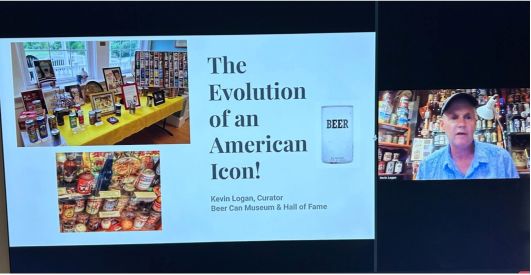By Madison Butkus
Hometown Weekly Reporter
Presenting for the first time in a virtual setting, The Beer Can Museum curator, Kevin Logan, took us for a journey through the evolution of the beer can, as well as highlighted some cans he has within his museum. While this museum is not open to the public, Logan wanted to share some of the amazing items he has within.
Sponsored by the Tewksbury Library, the Needham Free Public Library (NFPL) shared this online event with all who wanted to attend. According to the NFPL’s website, “The Beer Can Museum is a collection of more than 5,000 different beer cans, along with beer can folk art and crafts, beer can clothing, beer can telephones and radios, and a beer can and breweriana-related library.”
Located in East Taunton, MA, this museum can be found in the basement of Logan’s home and therefore is usually not open for tours. With the amount of memorabilia that Logan has acquired, he is looking to eventually open up a place that will be open to all. According to Logan, this is his first virtual presentation but he hopes to do many more down the road to spread the word about his work.
Of course, we cannot talk about the nostalgia of beer cans without learning how they were created. The process of canning food first sparked the creation of cans back in 1810 by a man named Peter Durand. This allowed the navy to finally eat good food that had a shelf life to it as well. Ironically enough, even though canning was becoming more and more popular across the country, it was not until 1858 that the first can opener was invented.
It then took until the 1930’s for the beer can to be finally created. This was mainly due to prohibition and two main challenges when creating the can. Logan went on to state, “The question always remained, ‘Why can’t we get beer in cans?’ Well, there’s two significant challenges. The first one is that beer is carbonated so the can has to be stronger and has to withstand ninety pounds per square inch versus only thirty five PSI for green beans or peaches. Secondly, beer and metal don’t get along very well. The very scientific term is called Metal Turbidity. Beer gets a sour taste when it comes into contact with tin plated steel or sodder.”
After years of testing, the beer can was finally created by American Can Co. using a thin layer of vinyl on the inside that would protect the beer’s taste from the metal. Even when created, many beer companies were hesitant to try it out. American Can Co. ended up offering Krueger all the installation and product for free to try out and stated that they only had to pay if the experiment was successful.
When tasting beer in a can for the first time, a survey was taken in which 91% said it tastes good, while 85% said it was better than draft beer. With this, the beer can industry took off and all other companies wanted in. In the first year of production, 160,000,000 beer cans were manufactured. Today, modern aluminum can manufacturers can produce around thirteen million cans a day.
Over the years, the beer can has changed in an abundance of ways. Logan is so intrigued by this that he even has a tattoo of a beer can on his leg. His dedication towards this hobby is astounding. To learn more about The Beer Can Museum and all that’s inside, please visit their website at www.beercanmuseum.org.























